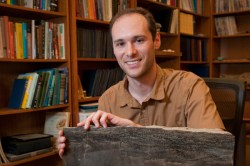
Photo by Krissy Venosdale.
Four and a half billion years is a hard number to digest. That’s the age of the Earth, and a lot has happened in that time. The geologic record contains dramatic climate swings, the formation of entire continents, the proliferation of new species — as well as mass extinctions. But no matter what has happened in the past, life goes on. Well, in the case of mass extinctions, at least some life does …
To help people get their heads around our role in all this, geologists use the analogy of a clock: If you compress all of the Earth’s history into a single day, humans do not show up on the scene until a minute before midnight.
 “When you have that viewpoint of looking at these events long afterward and seeing what happens in the aftermath, it tends to lead to interesting new evolutionary pathways in many cases,” says Stanford geology and environmental sciences professor Jonathan Payne. He quips that we “can’t be entirely sorry” about past mass extinctions because they “changed ecosystems in ways that ultimately led to the evolution of human beings.”
“When you have that viewpoint of looking at these events long afterward and seeing what happens in the aftermath, it tends to lead to interesting new evolutionary pathways in many cases,” says Stanford geology and environmental sciences professor Jonathan Payne. He quips that we “can’t be entirely sorry” about past mass extinctions because they “changed ecosystems in ways that ultimately led to the evolution of human beings.”
Thinking on this kind of deep earth time scale can offer some comfort in times like these. But perhaps it shouldn’t.
“Although the Earth will undoubtedly recover from whatever humans do to it, it won’t recover on a time scale that is relevant to us, our children, or our grandchildren,” he says. “One way of thinking about it is that anything we decide to do to the planet is permanent, for all practical purposes.”
I recently caught up with Payne to discuss geologic time, mass extinctions, and humans as a geologic force.
Free MP3. (Right click, select “Save Link As.”)
This interview is part of the Generation Anthropocene project, in which Stanford students partake in an inter-generational dialogue with scholars about living in an age when humans have become a major force shaping our world.



